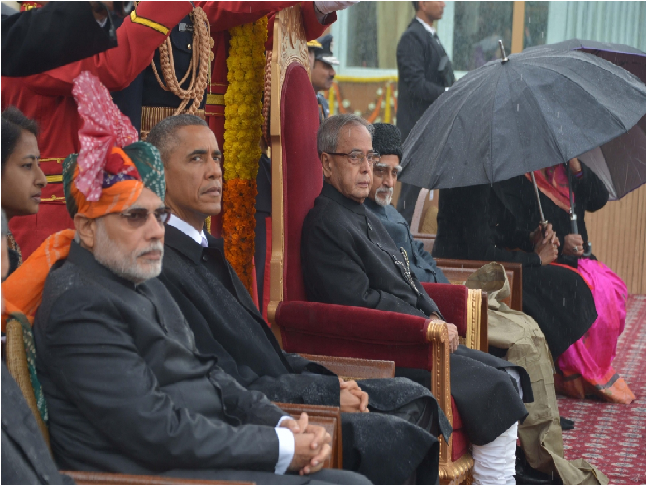When a Strategic Vision Turns Delusional
Not much to smile about?

NEW DELHI: President Barack Obama will leave Indian shores a little ahead of schedule tomorrow. A Taj Mahal visit was scratched so he could visit the Saudi kingdom and reaffirm vows of fealty with one of the U.S.’s indispensable allies. Despite the slight truncation, he would be leaving behind the warm glow of fulfilment among his Indian hosts.
The visit began amid serious worries. Strategic experts were virtually unanimous that a key metric for assessing its outcome would be its success in clearing the logjam in nuclear cooperation. In the slow-moving tableau of India’s engagement with the U.S. – which was tagged as the great “transformation” over a decade ago – this must be the most tortuous act.
A nuclear cooperation agreement was signed with the U.S. when Prime Minister Manmohan Singh met President George Bush in 2005. Once the glow of that achievement faded, its advocates found a host of devils nestling in the details. Some of these were cleared when Bush visited in 2006. But it took the expenditure of considerable political capital for Manmohan Singh to push through the agreement in the teeth of domestic opposition.
The rewards have been meagre or worse. A liability law India enacted had specific clauses, inserted at the insistence of the Left parties and the BJP, potentially holding nuclear equipment vendors accountable for accidents. This stuck in the craw of powerful U.S. corporations such as Westinghouse and General Electric. And India in turn found it deeply irksome that the U.S. should demand the power to track and audit nuclear material it supplied, through its entire life cycle.
As Obama landed in Delhi, talking heads on Indian television were already venting on the corrosive potential of the latter clause. One particularly aggressive commentator, a former military officer known for his volubility, bristled at the damage it could do to India’s strategic plans. He seemed unaware of the reality that the nuclear deal was premised upon a strict separation of civilian and military applications, that India was indeed already committed to submitting civilian facilities built under cooperative arrangements to International Atomic Energy Agency (IAEA) safeguards.
India’s objection was more limited: that with the IAEA already enforcing its safeguards, a further layer of inspection requests from the U.S. would be no more than an irritant.
The tenor of media commentary indeed only seemed to highlight how the engagement with the U.S. has become more a matter of optics than substance. The broader narrative is one of strategic partnership in restoring a power hierarchy to a world rapidly slipping into disorder. Nuclear cooperation, at best no more than symbolic of the wider agenda, has somehow become in the eyes of most strategic pundits, the whole substance of it. Weapons that will never be used and an energy source that today contributes no more than 2 percent of India’s total electricity mix, have come to represent all there is in the engagement with the U.S.
In the event, the overflow of media punditry seemed to agree that Modi’s decision to break protocol and seek a photo-op with Obama just as his aircraft touched down, may have worked the magic. By day’s end, the nuclear logjam had reportedly been broken.
Liability issues would be dealt with by an insurance fund that Indian nuclear utilities would create, effectively indemnifying U.S. equipment suppliers. The quantum of the fund spoken of was Rs 1,500 crore, or roughly US$ 250 crore at current exchange rates. By way of comparison, the compensation paid by Union Carbide Corporation for Bhopal’s chemical holocaust in 1984 was US$ 470 million, a quantum that was found grossly inadequate, even insulting to the memory of the victims.
On the related issue of clause 46 in the Nuclear Liability Law, which empowers Indian nationals to sue foreign corporations under the law of torts, there is yet, enigmatic silence. If there have been some secret assurances rendered that this clause will be diluted – a power that belongs exclusively to the legislature or judiciary – these are unlikely to escape political scrutiny at a later stage.
It is of course a particularly myopic vision that sees nuclear power, with its uncertain and opportunistic economics – not to mention its unaddressed issues of waste disposal and decommissioning -- as a viable option to deal with the global warming threat inherent in the carbon fuel cycle. And despite much talk and rather pretty turns of phrase, there was nothing by way of a shared approach to climate change that emerged from the Delhi summit.
Strategic issues were dealt with in a decision to extend the military cooperation protocol initiated in 2004. There was also a tacit signal to the Asian region and a monitory warning to China, that the U.S. and India shared a common interest in keeping the continent safe from its hegemonistic designs. An earlier joint statement by the two leaders which focused on the need to maintain freedom of navigation through the South China Sea, had drawn a firm rebuff from China, which insists that this is an issue for the littoral states to sort out among themselves.
For India to endanger neighbourhood relations for the edification of a distant superpower, whose influence is distinctly on the wane, seems like strategic folly to a number of experts. But that was the course that India embarked on in 1998, with dreams of blasting its way into the superpower league with a series of nuclear tests in the Rajasthan desert. The vision remains as influential as ever. But with very little to show for it, other than rising tensions in the neighbourhood and faltering economic fortunes, it is rapidly being recognised as delusional or worse.



